Essay: Trauma Informed Care Implementation in Family Violence
VerifiedAdded on 2023/06/09
|10
|2538
|350
Essay
AI Summary
This essay provides an in-depth analysis of trauma-informed care (TIC) and its practical application, particularly within the context of a family violence hotline. The introduction defines evidenced-based practice and highlights the significance of TIC in addressing trauma, especially in family violence situations. The main body is divided into three parts: Part A introduces TIC, its principles (safety, choice, collaboration, trustworthiness, and empowerment), and the use of checklists for organized care. Part B presents a checklist used at organizational, program, and staff levels to evaluate TIC implementation. Part C offers a critical reflection on the author's learning experiences and the benefits of TIC, including improved patient engagement and health outcomes. The conclusion summarizes the importance of TIC in creating a positive environment for individuals dealing with traumatic events. References to relevant literature are also included.

Evidenced based essay
Paraphrase This Document
Need a fresh take? Get an instant paraphrase of this document with our AI Paraphraser
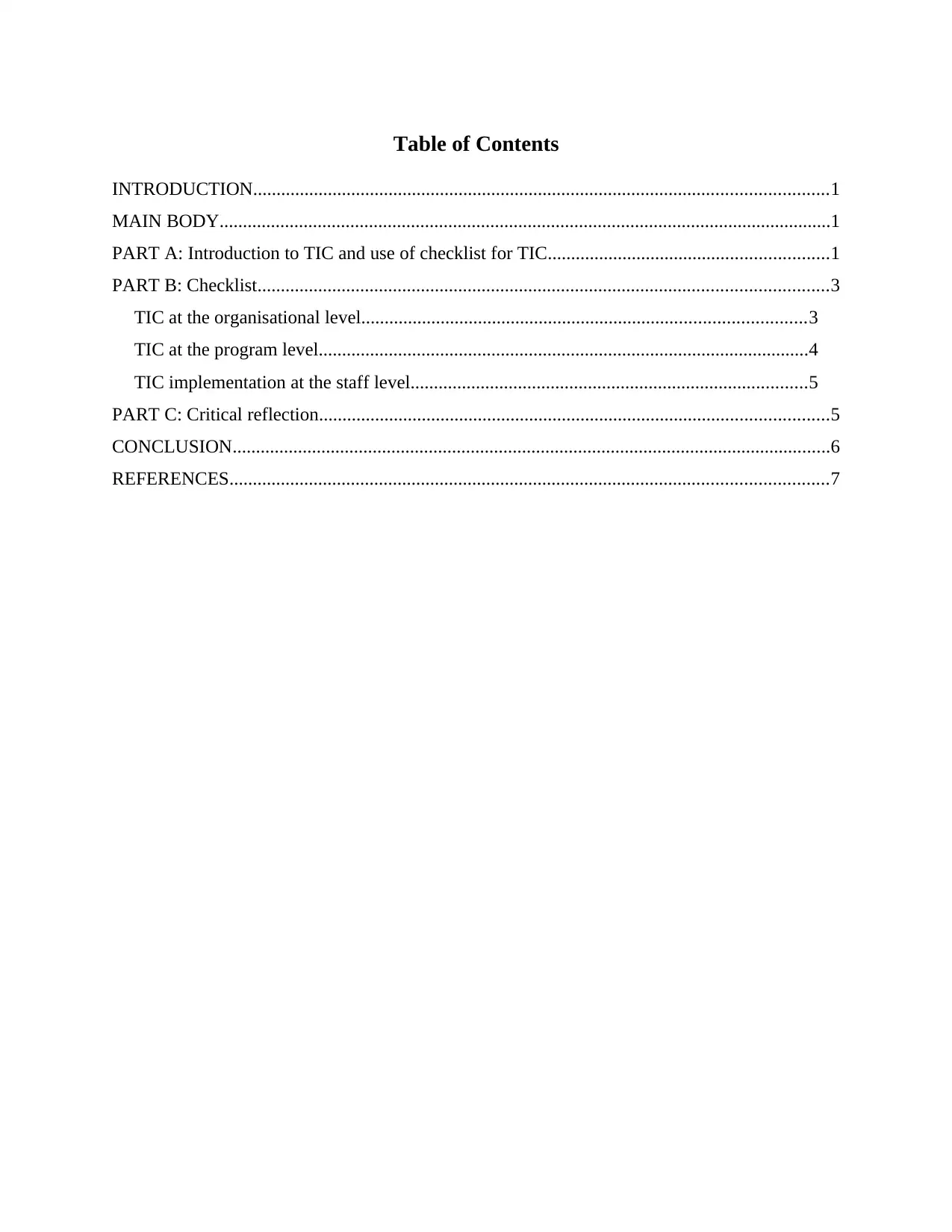
Table of Contents
INTRODUCTION...........................................................................................................................1
MAIN BODY...................................................................................................................................1
PART A: Introduction to TIC and use of checklist for TIC............................................................1
PART B: Checklist..........................................................................................................................3
TIC at the organisational level...............................................................................................3
TIC at the program level.........................................................................................................4
TIC implementation at the staff level.....................................................................................5
PART C: Critical reflection.............................................................................................................5
CONCLUSION................................................................................................................................6
REFERENCES................................................................................................................................7
INTRODUCTION...........................................................................................................................1
MAIN BODY...................................................................................................................................1
PART A: Introduction to TIC and use of checklist for TIC............................................................1
PART B: Checklist..........................................................................................................................3
TIC at the organisational level...............................................................................................3
TIC at the program level.........................................................................................................4
TIC implementation at the staff level.....................................................................................5
PART C: Critical reflection.............................................................................................................5
CONCLUSION................................................................................................................................6
REFERENCES................................................................................................................................7
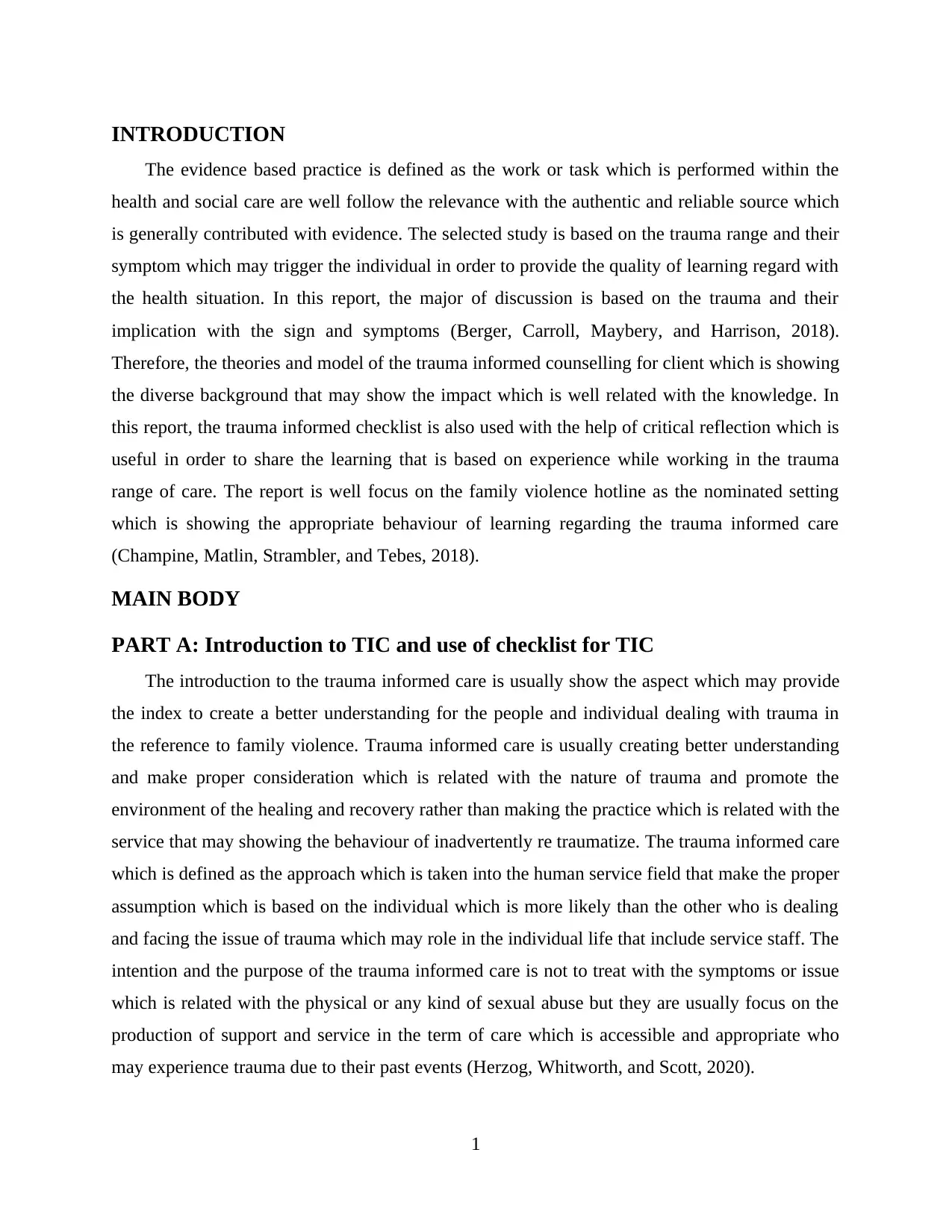
INTRODUCTION
The evidence based practice is defined as the work or task which is performed within the
health and social care are well follow the relevance with the authentic and reliable source which
is generally contributed with evidence. The selected study is based on the trauma range and their
symptom which may trigger the individual in order to provide the quality of learning regard with
the health situation. In this report, the major of discussion is based on the trauma and their
implication with the sign and symptoms (Berger, Carroll, Maybery, and Harrison, 2018).
Therefore, the theories and model of the trauma informed counselling for client which is showing
the diverse background that may show the impact which is well related with the knowledge. In
this report, the trauma informed checklist is also used with the help of critical reflection which is
useful in order to share the learning that is based on experience while working in the trauma
range of care. The report is well focus on the family violence hotline as the nominated setting
which is showing the appropriate behaviour of learning regarding the trauma informed care
(Champine, Matlin, Strambler, and Tebes, 2018).
MAIN BODY
PART A: Introduction to TIC and use of checklist for TIC
The introduction to the trauma informed care is usually show the aspect which may provide
the index to create a better understanding for the people and individual dealing with trauma in
the reference to family violence. Trauma informed care is usually creating better understanding
and make proper consideration which is related with the nature of trauma and promote the
environment of the healing and recovery rather than making the practice which is related with the
service that may showing the behaviour of inadvertently re traumatize. The trauma informed care
which is defined as the approach which is taken into the human service field that make the proper
assumption which is based on the individual which is more likely than the other who is dealing
and facing the issue of trauma which may role in the individual life that include service staff. The
intention and the purpose of the trauma informed care is not to treat with the symptoms or issue
which is related with the physical or any kind of sexual abuse but they are usually focus on the
production of support and service in the term of care which is accessible and appropriate who
may experience trauma due to their past events (Herzog, Whitworth, and Scott, 2020).
1
The evidence based practice is defined as the work or task which is performed within the
health and social care are well follow the relevance with the authentic and reliable source which
is generally contributed with evidence. The selected study is based on the trauma range and their
symptom which may trigger the individual in order to provide the quality of learning regard with
the health situation. In this report, the major of discussion is based on the trauma and their
implication with the sign and symptoms (Berger, Carroll, Maybery, and Harrison, 2018).
Therefore, the theories and model of the trauma informed counselling for client which is showing
the diverse background that may show the impact which is well related with the knowledge. In
this report, the trauma informed checklist is also used with the help of critical reflection which is
useful in order to share the learning that is based on experience while working in the trauma
range of care. The report is well focus on the family violence hotline as the nominated setting
which is showing the appropriate behaviour of learning regarding the trauma informed care
(Champine, Matlin, Strambler, and Tebes, 2018).
MAIN BODY
PART A: Introduction to TIC and use of checklist for TIC
The introduction to the trauma informed care is usually show the aspect which may provide
the index to create a better understanding for the people and individual dealing with trauma in
the reference to family violence. Trauma informed care is usually creating better understanding
and make proper consideration which is related with the nature of trauma and promote the
environment of the healing and recovery rather than making the practice which is related with the
service that may showing the behaviour of inadvertently re traumatize. The trauma informed care
which is defined as the approach which is taken into the human service field that make the proper
assumption which is based on the individual which is more likely than the other who is dealing
and facing the issue of trauma which may role in the individual life that include service staff. The
intention and the purpose of the trauma informed care is not to treat with the symptoms or issue
which is related with the physical or any kind of sexual abuse but they are usually focus on the
production of support and service in the term of care which is accessible and appropriate who
may experience trauma due to their past events (Herzog, Whitworth, and Scott, 2020).
1
⊘ This is a preview!⊘
Do you want full access?
Subscribe today to unlock all pages.

Trusted by 1+ million students worldwide
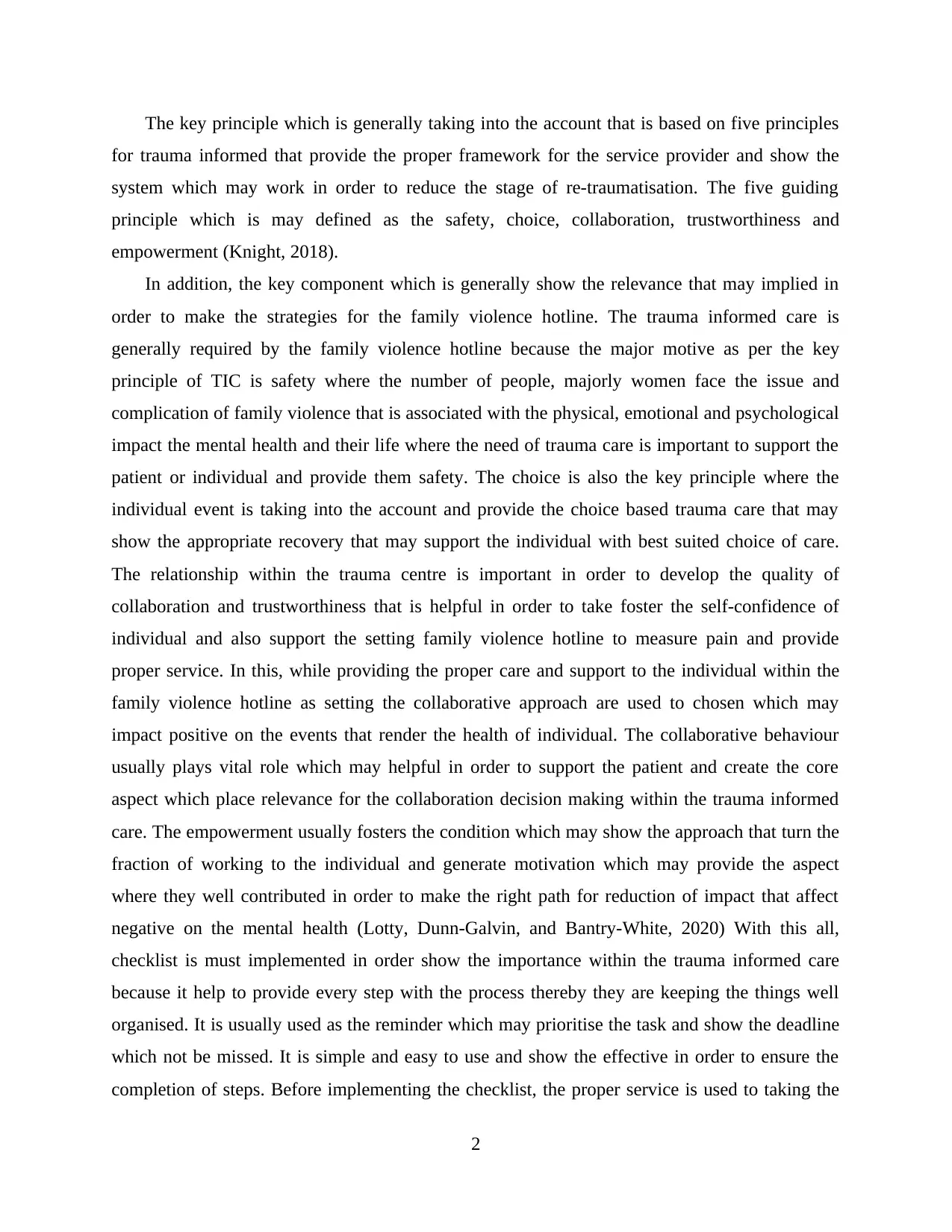
The key principle which is generally taking into the account that is based on five principles
for trauma informed that provide the proper framework for the service provider and show the
system which may work in order to reduce the stage of re-traumatisation. The five guiding
principle which is may defined as the safety, choice, collaboration, trustworthiness and
empowerment (Knight, 2018).
In addition, the key component which is generally show the relevance that may implied in
order to make the strategies for the family violence hotline. The trauma informed care is
generally required by the family violence hotline because the major motive as per the key
principle of TIC is safety where the number of people, majorly women face the issue and
complication of family violence that is associated with the physical, emotional and psychological
impact the mental health and their life where the need of trauma care is important to support the
patient or individual and provide them safety. The choice is also the key principle where the
individual event is taking into the account and provide the choice based trauma care that may
show the appropriate recovery that may support the individual with best suited choice of care.
The relationship within the trauma centre is important in order to develop the quality of
collaboration and trustworthiness that is helpful in order to take foster the self-confidence of
individual and also support the setting family violence hotline to measure pain and provide
proper service. In this, while providing the proper care and support to the individual within the
family violence hotline as setting the collaborative approach are used to chosen which may
impact positive on the events that render the health of individual. The collaborative behaviour
usually plays vital role which may helpful in order to support the patient and create the core
aspect which place relevance for the collaboration decision making within the trauma informed
care. The empowerment usually fosters the condition which may show the approach that turn the
fraction of working to the individual and generate motivation which may provide the aspect
where they well contributed in order to make the right path for reduction of impact that affect
negative on the mental health (Lotty, Dunn-Galvin, and Bantry-White, 2020) With this all,
checklist is must implemented in order show the importance within the trauma informed care
because it help to provide every step with the process thereby they are keeping the things well
organised. It is usually used as the reminder which may prioritise the task and show the deadline
which not be missed. It is simple and easy to use and show the effective in order to ensure the
completion of steps. Before implementing the checklist, the proper service is used to taking the
2
for trauma informed that provide the proper framework for the service provider and show the
system which may work in order to reduce the stage of re-traumatisation. The five guiding
principle which is may defined as the safety, choice, collaboration, trustworthiness and
empowerment (Knight, 2018).
In addition, the key component which is generally show the relevance that may implied in
order to make the strategies for the family violence hotline. The trauma informed care is
generally required by the family violence hotline because the major motive as per the key
principle of TIC is safety where the number of people, majorly women face the issue and
complication of family violence that is associated with the physical, emotional and psychological
impact the mental health and their life where the need of trauma care is important to support the
patient or individual and provide them safety. The choice is also the key principle where the
individual event is taking into the account and provide the choice based trauma care that may
show the appropriate recovery that may support the individual with best suited choice of care.
The relationship within the trauma centre is important in order to develop the quality of
collaboration and trustworthiness that is helpful in order to take foster the self-confidence of
individual and also support the setting family violence hotline to measure pain and provide
proper service. In this, while providing the proper care and support to the individual within the
family violence hotline as setting the collaborative approach are used to chosen which may
impact positive on the events that render the health of individual. The collaborative behaviour
usually plays vital role which may helpful in order to support the patient and create the core
aspect which place relevance for the collaboration decision making within the trauma informed
care. The empowerment usually fosters the condition which may show the approach that turn the
fraction of working to the individual and generate motivation which may provide the aspect
where they well contributed in order to make the right path for reduction of impact that affect
negative on the mental health (Lotty, Dunn-Galvin, and Bantry-White, 2020) With this all,
checklist is must implemented in order show the importance within the trauma informed care
because it help to provide every step with the process thereby they are keeping the things well
organised. It is usually used as the reminder which may prioritise the task and show the deadline
which not be missed. It is simple and easy to use and show the effective in order to ensure the
completion of steps. Before implementing the checklist, the proper service is used to taking the
2
Paraphrase This Document
Need a fresh take? Get an instant paraphrase of this document with our AI Paraphraser
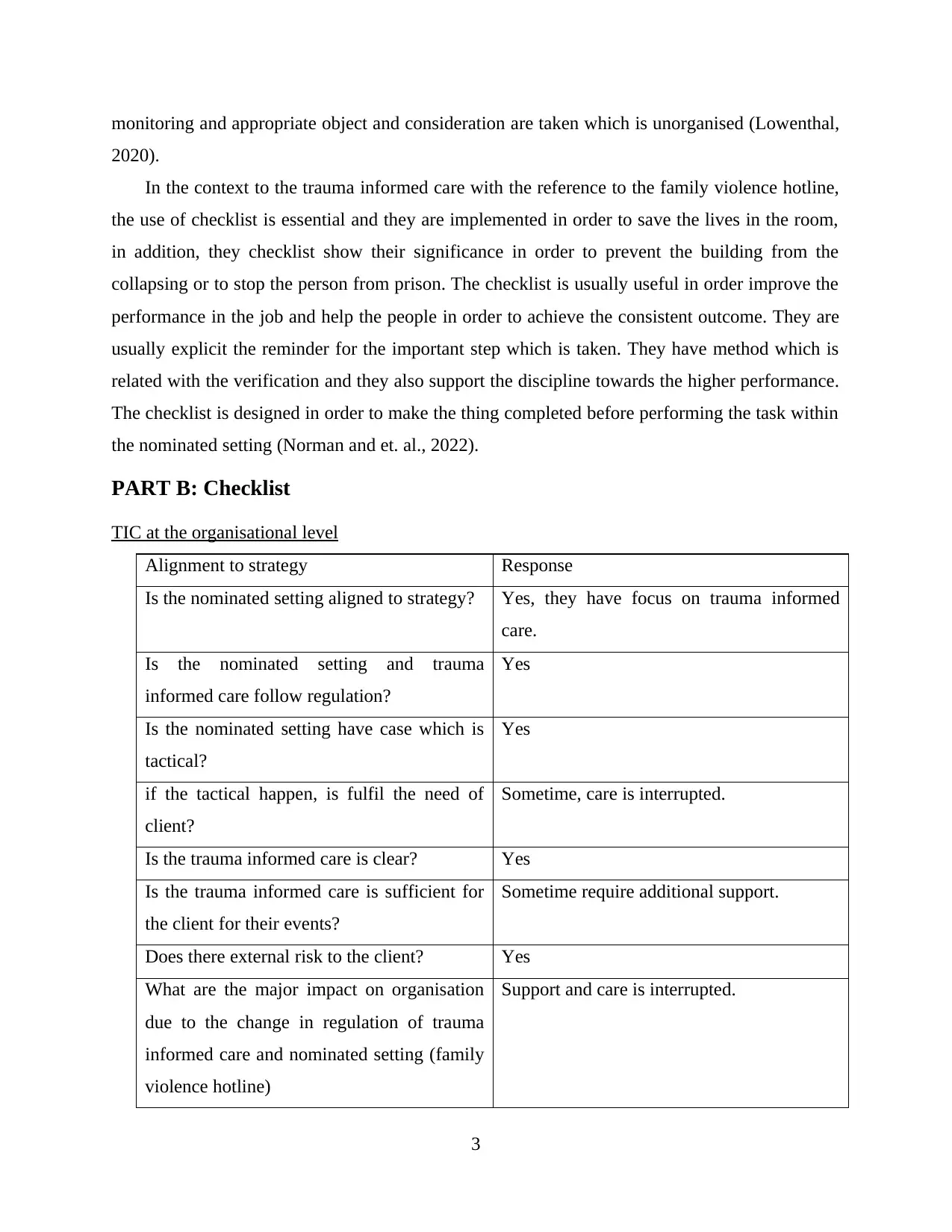
monitoring and appropriate object and consideration are taken which is unorganised (Lowenthal,
2020).
In the context to the trauma informed care with the reference to the family violence hotline,
the use of checklist is essential and they are implemented in order to save the lives in the room,
in addition, they checklist show their significance in order to prevent the building from the
collapsing or to stop the person from prison. The checklist is usually useful in order improve the
performance in the job and help the people in order to achieve the consistent outcome. They are
usually explicit the reminder for the important step which is taken. They have method which is
related with the verification and they also support the discipline towards the higher performance.
The checklist is designed in order to make the thing completed before performing the task within
the nominated setting (Norman and et. al., 2022).
PART B: Checklist
TIC at the organisational level
Alignment to strategy Response
Is the nominated setting aligned to strategy? Yes, they have focus on trauma informed
care.
Is the nominated setting and trauma
informed care follow regulation?
Yes
Is the nominated setting have case which is
tactical?
Yes
if the tactical happen, is fulfil the need of
client?
Sometime, care is interrupted.
Is the trauma informed care is clear? Yes
Is the trauma informed care is sufficient for
the client for their events?
Sometime require additional support.
Does there external risk to the client? Yes
What are the major impact on organisation
due to the change in regulation of trauma
informed care and nominated setting (family
violence hotline)
Support and care is interrupted.
3
2020).
In the context to the trauma informed care with the reference to the family violence hotline,
the use of checklist is essential and they are implemented in order to save the lives in the room,
in addition, they checklist show their significance in order to prevent the building from the
collapsing or to stop the person from prison. The checklist is usually useful in order improve the
performance in the job and help the people in order to achieve the consistent outcome. They are
usually explicit the reminder for the important step which is taken. They have method which is
related with the verification and they also support the discipline towards the higher performance.
The checklist is designed in order to make the thing completed before performing the task within
the nominated setting (Norman and et. al., 2022).
PART B: Checklist
TIC at the organisational level
Alignment to strategy Response
Is the nominated setting aligned to strategy? Yes, they have focus on trauma informed
care.
Is the nominated setting and trauma
informed care follow regulation?
Yes
Is the nominated setting have case which is
tactical?
Yes
if the tactical happen, is fulfil the need of
client?
Sometime, care is interrupted.
Is the trauma informed care is clear? Yes
Is the trauma informed care is sufficient for
the client for their events?
Sometime require additional support.
Does there external risk to the client? Yes
What are the major impact on organisation
due to the change in regulation of trauma
informed care and nominated setting (family
violence hotline)
Support and care is interrupted.
3
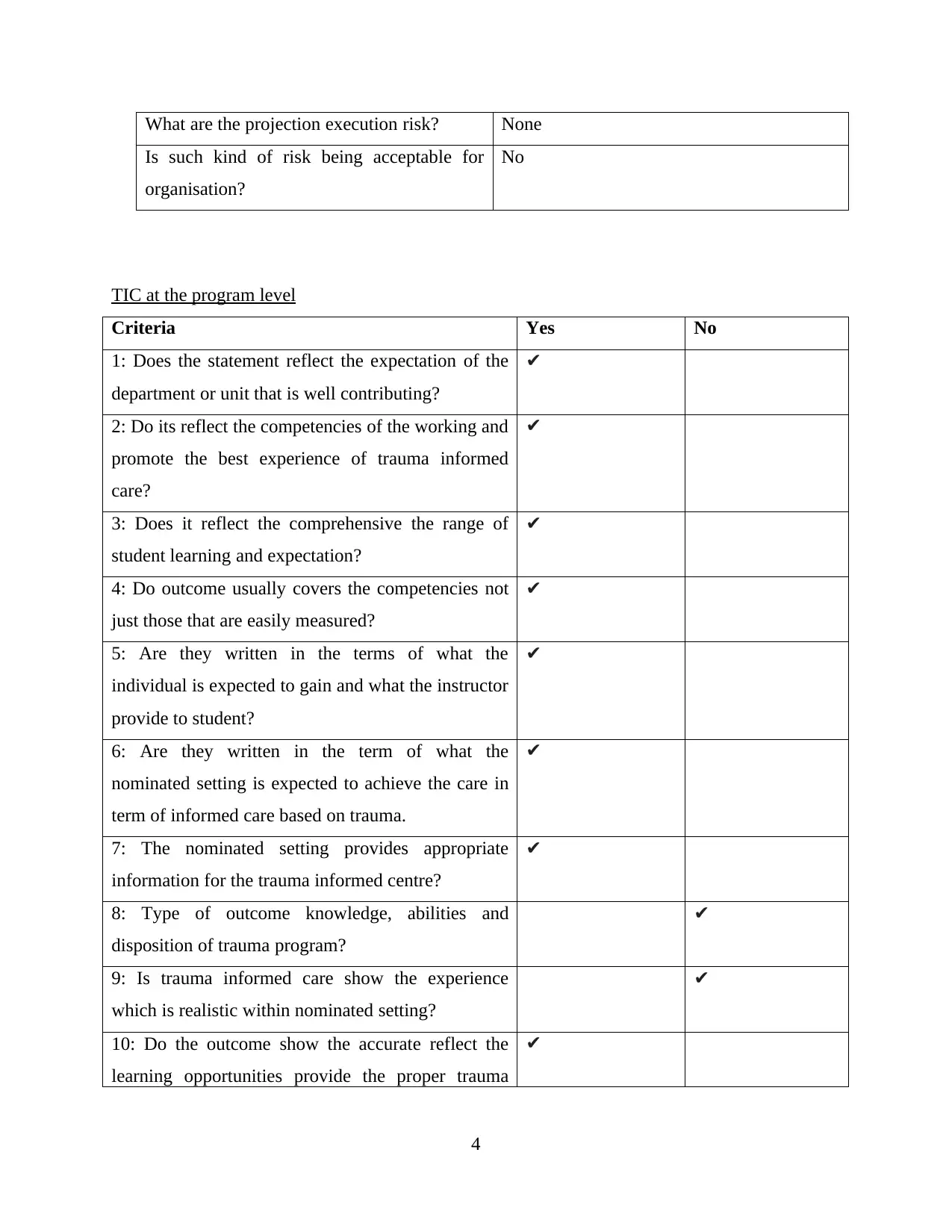
What are the projection execution risk? None
Is such kind of risk being acceptable for
organisation?
No
TIC at the program level
Criteria Yes No
1: Does the statement reflect the expectation of the
department or unit that is well contributing?
✔
2: Do its reflect the competencies of the working and
promote the best experience of trauma informed
care?
✔
3: Does it reflect the comprehensive the range of
student learning and expectation?
✔
4: Do outcome usually covers the competencies not
just those that are easily measured?
✔
5: Are they written in the terms of what the
individual is expected to gain and what the instructor
provide to student?
✔
6: Are they written in the term of what the
nominated setting is expected to achieve the care in
term of informed care based on trauma.
✔
7: The nominated setting provides appropriate
information for the trauma informed centre?
✔
8: Type of outcome knowledge, abilities and
disposition of trauma program?
✔
9: Is trauma informed care show the experience
which is realistic within nominated setting?
✔
10: Do the outcome show the accurate reflect the
learning opportunities provide the proper trauma
✔
4
Is such kind of risk being acceptable for
organisation?
No
TIC at the program level
Criteria Yes No
1: Does the statement reflect the expectation of the
department or unit that is well contributing?
✔
2: Do its reflect the competencies of the working and
promote the best experience of trauma informed
care?
✔
3: Does it reflect the comprehensive the range of
student learning and expectation?
✔
4: Do outcome usually covers the competencies not
just those that are easily measured?
✔
5: Are they written in the terms of what the
individual is expected to gain and what the instructor
provide to student?
✔
6: Are they written in the term of what the
nominated setting is expected to achieve the care in
term of informed care based on trauma.
✔
7: The nominated setting provides appropriate
information for the trauma informed centre?
✔
8: Type of outcome knowledge, abilities and
disposition of trauma program?
✔
9: Is trauma informed care show the experience
which is realistic within nominated setting?
✔
10: Do the outcome show the accurate reflect the
learning opportunities provide the proper trauma
✔
4
⊘ This is a preview!⊘
Do you want full access?
Subscribe today to unlock all pages.

Trusted by 1+ million students worldwide
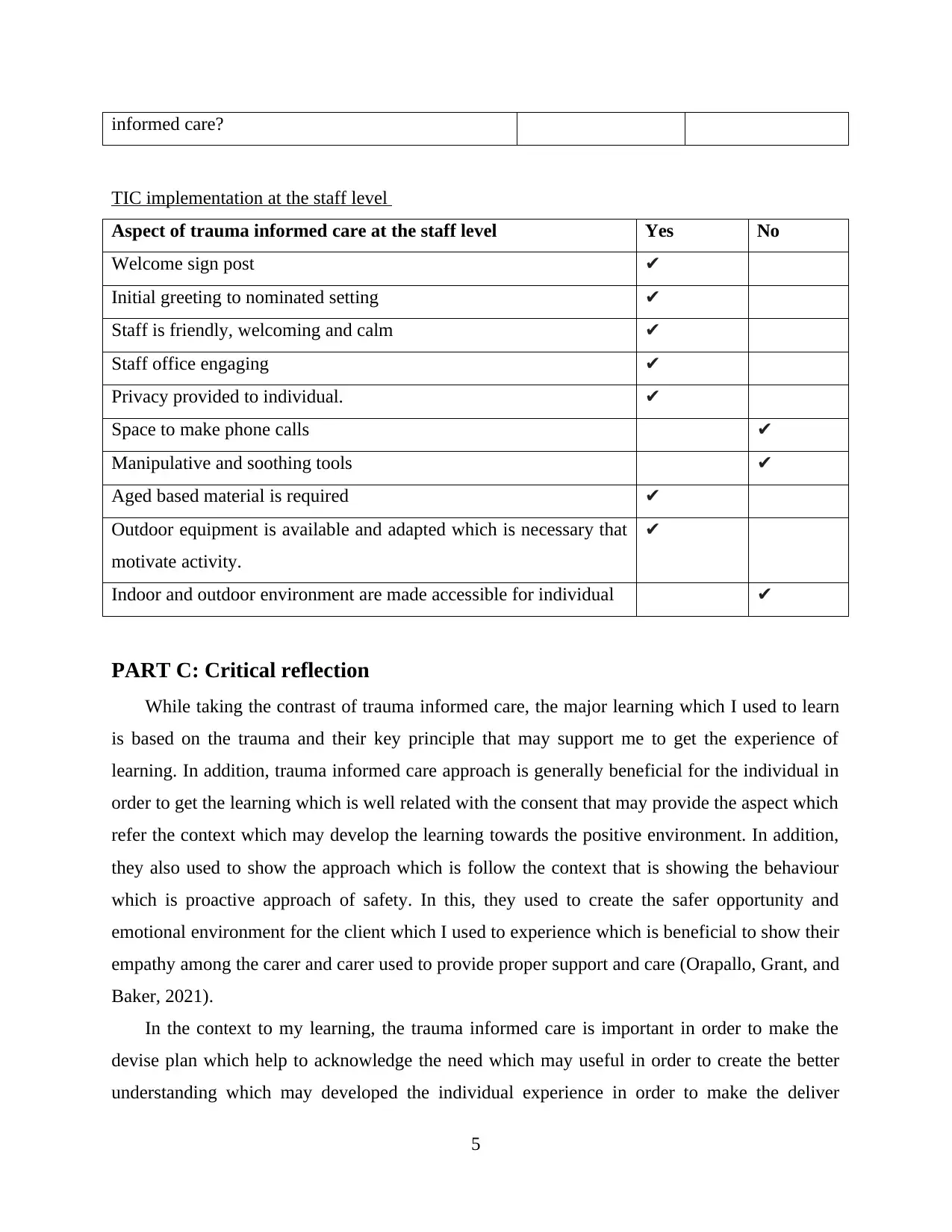
informed care?
TIC implementation at the staff level
Aspect of trauma informed care at the staff level Yes No
Welcome sign post ✔
Initial greeting to nominated setting ✔
Staff is friendly, welcoming and calm ✔
Staff office engaging ✔
Privacy provided to individual. ✔
Space to make phone calls ✔
Manipulative and soothing tools ✔
Aged based material is required ✔
Outdoor equipment is available and adapted which is necessary that
motivate activity.
✔
Indoor and outdoor environment are made accessible for individual ✔
PART C: Critical reflection
While taking the contrast of trauma informed care, the major learning which I used to learn
is based on the trauma and their key principle that may support me to get the experience of
learning. In addition, trauma informed care approach is generally beneficial for the individual in
order to get the learning which is well related with the consent that may provide the aspect which
refer the context which may develop the learning towards the positive environment. In addition,
they also used to show the approach which is follow the context that is showing the behaviour
which is proactive approach of safety. In this, they used to create the safer opportunity and
emotional environment for the client which I used to experience which is beneficial to show their
empathy among the carer and carer used to provide proper support and care (Orapallo, Grant, and
Baker, 2021).
In the context to my learning, the trauma informed care is important in order to make the
devise plan which help to acknowledge the need which may useful in order to create the better
understanding which may developed the individual experience in order to make the deliver
5
TIC implementation at the staff level
Aspect of trauma informed care at the staff level Yes No
Welcome sign post ✔
Initial greeting to nominated setting ✔
Staff is friendly, welcoming and calm ✔
Staff office engaging ✔
Privacy provided to individual. ✔
Space to make phone calls ✔
Manipulative and soothing tools ✔
Aged based material is required ✔
Outdoor equipment is available and adapted which is necessary that
motivate activity.
✔
Indoor and outdoor environment are made accessible for individual ✔
PART C: Critical reflection
While taking the contrast of trauma informed care, the major learning which I used to learn
is based on the trauma and their key principle that may support me to get the experience of
learning. In addition, trauma informed care approach is generally beneficial for the individual in
order to get the learning which is well related with the consent that may provide the aspect which
refer the context which may develop the learning towards the positive environment. In addition,
they also used to show the approach which is follow the context that is showing the behaviour
which is proactive approach of safety. In this, they used to create the safer opportunity and
emotional environment for the client which I used to experience which is beneficial to show their
empathy among the carer and carer used to provide proper support and care (Orapallo, Grant, and
Baker, 2021).
In the context to my learning, the trauma informed care is important in order to make the
devise plan which help to acknowledge the need which may useful in order to create the better
understanding which may developed the individual experience in order to make the deliver
5
Paraphrase This Document
Need a fresh take? Get an instant paraphrase of this document with our AI Paraphraser
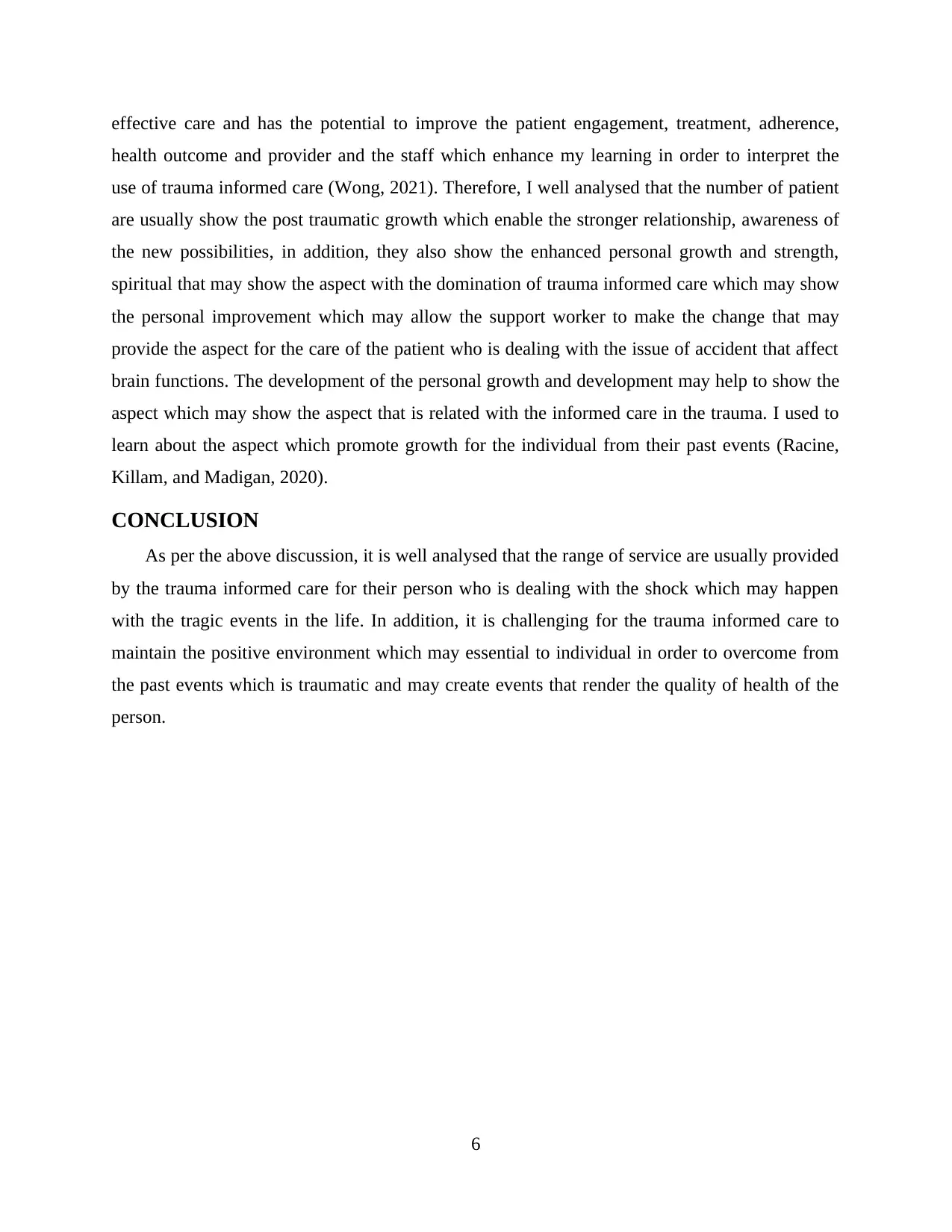
effective care and has the potential to improve the patient engagement, treatment, adherence,
health outcome and provider and the staff which enhance my learning in order to interpret the
use of trauma informed care (Wong, 2021). Therefore, I well analysed that the number of patient
are usually show the post traumatic growth which enable the stronger relationship, awareness of
the new possibilities, in addition, they also show the enhanced personal growth and strength,
spiritual that may show the aspect with the domination of trauma informed care which may show
the personal improvement which may allow the support worker to make the change that may
provide the aspect for the care of the patient who is dealing with the issue of accident that affect
brain functions. The development of the personal growth and development may help to show the
aspect which may show the aspect that is related with the informed care in the trauma. I used to
learn about the aspect which promote growth for the individual from their past events (Racine,
Killam, and Madigan, 2020).
CONCLUSION
As per the above discussion, it is well analysed that the range of service are usually provided
by the trauma informed care for their person who is dealing with the shock which may happen
with the tragic events in the life. In addition, it is challenging for the trauma informed care to
maintain the positive environment which may essential to individual in order to overcome from
the past events which is traumatic and may create events that render the quality of health of the
person.
6
health outcome and provider and the staff which enhance my learning in order to interpret the
use of trauma informed care (Wong, 2021). Therefore, I well analysed that the number of patient
are usually show the post traumatic growth which enable the stronger relationship, awareness of
the new possibilities, in addition, they also show the enhanced personal growth and strength,
spiritual that may show the aspect with the domination of trauma informed care which may show
the personal improvement which may allow the support worker to make the change that may
provide the aspect for the care of the patient who is dealing with the issue of accident that affect
brain functions. The development of the personal growth and development may help to show the
aspect which may show the aspect that is related with the informed care in the trauma. I used to
learn about the aspect which promote growth for the individual from their past events (Racine,
Killam, and Madigan, 2020).
CONCLUSION
As per the above discussion, it is well analysed that the range of service are usually provided
by the trauma informed care for their person who is dealing with the shock which may happen
with the tragic events in the life. In addition, it is challenging for the trauma informed care to
maintain the positive environment which may essential to individual in order to overcome from
the past events which is traumatic and may create events that render the quality of health of the
person.
6
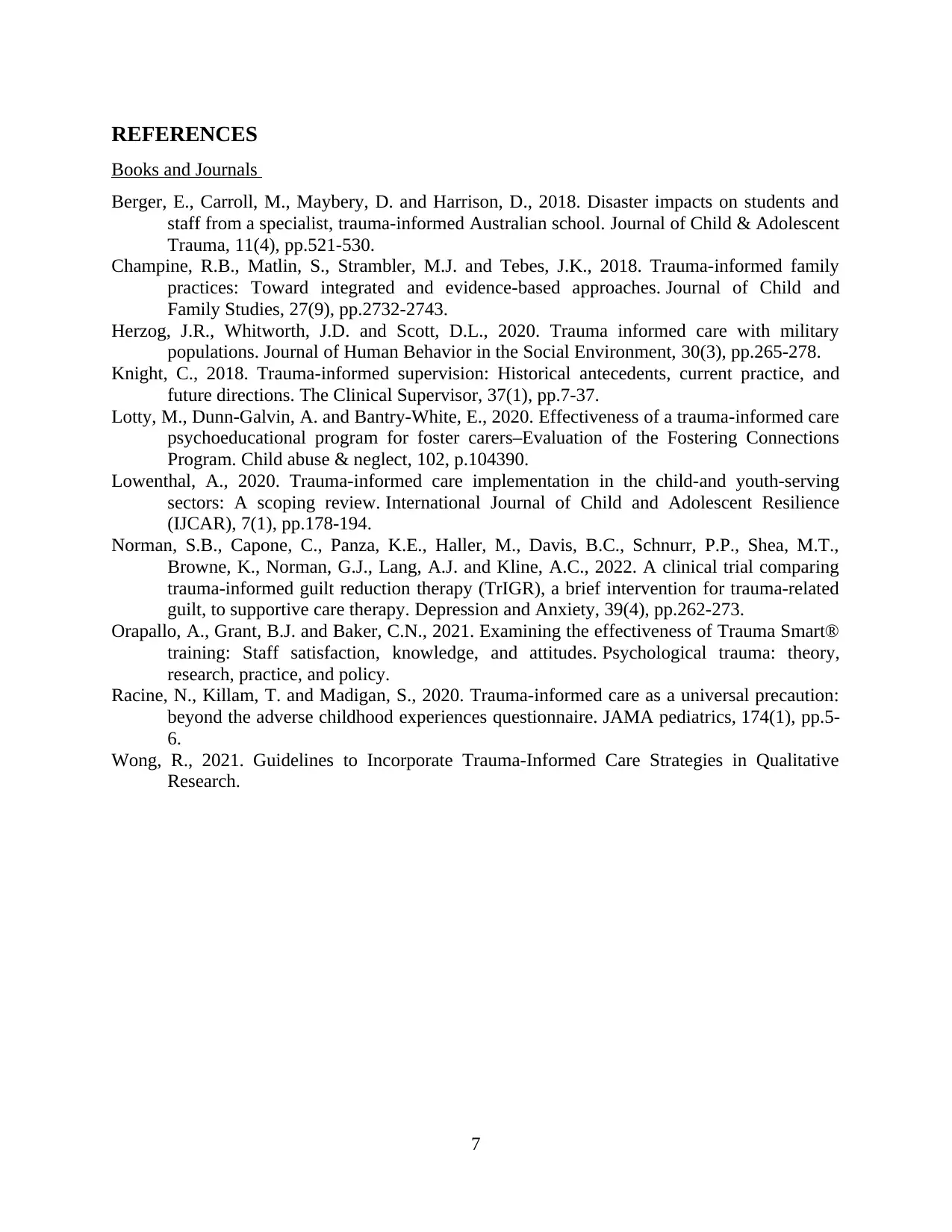
REFERENCES
Books and Journals
Berger, E., Carroll, M., Maybery, D. and Harrison, D., 2018. Disaster impacts on students and
staff from a specialist, trauma-informed Australian school. Journal of Child & Adolescent
Trauma, 11(4), pp.521-530.
Champine, R.B., Matlin, S., Strambler, M.J. and Tebes, J.K., 2018. Trauma-informed family
practices: Toward integrated and evidence-based approaches. Journal of Child and
Family Studies, 27(9), pp.2732-2743.
Herzog, J.R., Whitworth, J.D. and Scott, D.L., 2020. Trauma informed care with military
populations. Journal of Human Behavior in the Social Environment, 30(3), pp.265-278.
Knight, C., 2018. Trauma-informed supervision: Historical antecedents, current practice, and
future directions. The Clinical Supervisor, 37(1), pp.7-37.
Lotty, M., Dunn-Galvin, A. and Bantry-White, E., 2020. Effectiveness of a trauma-informed care
psychoeducational program for foster carers–Evaluation of the Fostering Connections
Program. Child abuse & neglect, 102, p.104390.
Lowenthal, A., 2020. Trauma-informed care implementation in the child-and youth-serving
sectors: A scoping review. International Journal of Child and Adolescent Resilience
(IJCAR), 7(1), pp.178-194.
Norman, S.B., Capone, C., Panza, K.E., Haller, M., Davis, B.C., Schnurr, P.P., Shea, M.T.,
Browne, K., Norman, G.J., Lang, A.J. and Kline, A.C., 2022. A clinical trial comparing
trauma‐informed guilt reduction therapy (TrIGR), a brief intervention for trauma‐related
guilt, to supportive care therapy. Depression and Anxiety, 39(4), pp.262-273.
Orapallo, A., Grant, B.J. and Baker, C.N., 2021. Examining the effectiveness of Trauma Smart®
training: Staff satisfaction, knowledge, and attitudes. Psychological trauma: theory,
research, practice, and policy.
Racine, N., Killam, T. and Madigan, S., 2020. Trauma-informed care as a universal precaution:
beyond the adverse childhood experiences questionnaire. JAMA pediatrics, 174(1), pp.5-
6.
Wong, R., 2021. Guidelines to Incorporate Trauma-Informed Care Strategies in Qualitative
Research.
7
Books and Journals
Berger, E., Carroll, M., Maybery, D. and Harrison, D., 2018. Disaster impacts on students and
staff from a specialist, trauma-informed Australian school. Journal of Child & Adolescent
Trauma, 11(4), pp.521-530.
Champine, R.B., Matlin, S., Strambler, M.J. and Tebes, J.K., 2018. Trauma-informed family
practices: Toward integrated and evidence-based approaches. Journal of Child and
Family Studies, 27(9), pp.2732-2743.
Herzog, J.R., Whitworth, J.D. and Scott, D.L., 2020. Trauma informed care with military
populations. Journal of Human Behavior in the Social Environment, 30(3), pp.265-278.
Knight, C., 2018. Trauma-informed supervision: Historical antecedents, current practice, and
future directions. The Clinical Supervisor, 37(1), pp.7-37.
Lotty, M., Dunn-Galvin, A. and Bantry-White, E., 2020. Effectiveness of a trauma-informed care
psychoeducational program for foster carers–Evaluation of the Fostering Connections
Program. Child abuse & neglect, 102, p.104390.
Lowenthal, A., 2020. Trauma-informed care implementation in the child-and youth-serving
sectors: A scoping review. International Journal of Child and Adolescent Resilience
(IJCAR), 7(1), pp.178-194.
Norman, S.B., Capone, C., Panza, K.E., Haller, M., Davis, B.C., Schnurr, P.P., Shea, M.T.,
Browne, K., Norman, G.J., Lang, A.J. and Kline, A.C., 2022. A clinical trial comparing
trauma‐informed guilt reduction therapy (TrIGR), a brief intervention for trauma‐related
guilt, to supportive care therapy. Depression and Anxiety, 39(4), pp.262-273.
Orapallo, A., Grant, B.J. and Baker, C.N., 2021. Examining the effectiveness of Trauma Smart®
training: Staff satisfaction, knowledge, and attitudes. Psychological trauma: theory,
research, practice, and policy.
Racine, N., Killam, T. and Madigan, S., 2020. Trauma-informed care as a universal precaution:
beyond the adverse childhood experiences questionnaire. JAMA pediatrics, 174(1), pp.5-
6.
Wong, R., 2021. Guidelines to Incorporate Trauma-Informed Care Strategies in Qualitative
Research.
7
⊘ This is a preview!⊘
Do you want full access?
Subscribe today to unlock all pages.

Trusted by 1+ million students worldwide

8
1 out of 10
Related Documents
Your All-in-One AI-Powered Toolkit for Academic Success.
+13062052269
info@desklib.com
Available 24*7 on WhatsApp / Email
![[object Object]](/_next/static/media/star-bottom.7253800d.svg)
Unlock your academic potential
Copyright © 2020–2025 A2Z Services. All Rights Reserved. Developed and managed by ZUCOL.




